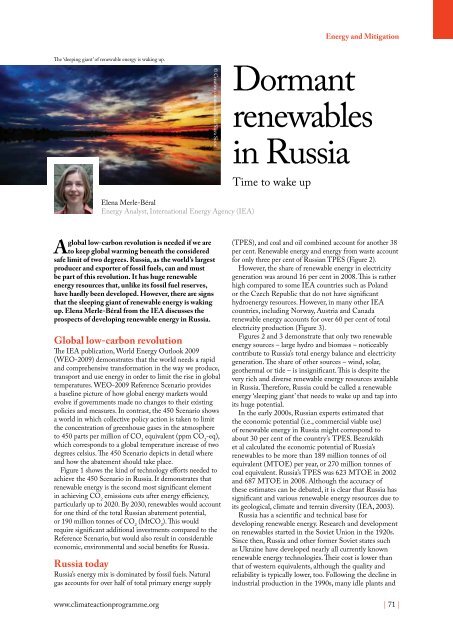Climate Action 2010-2011
Create successful ePaper yourself
Turn your PDF publications into a flip-book with our unique Google optimized e-Paper software.
Energy and Mitigation<br />
The ‘sleeping giant’ of renewable energy is waking up.<br />
© Creative commons/flickr/Slava Sizov<br />
Dormant<br />
renewables<br />
in Russia<br />
Time to wake up<br />
Elena Merle-Béral<br />
Energy Analyst, International Energy Agency (IEA)<br />
global low-carbon revolution is needed if we are<br />
A to keep global warming beneath the considered<br />
safe limit of two degrees. Russia, as the world’s largest<br />
producer and exporter of fossil fuels, can and must<br />
be part of this revolution. It has huge renewable<br />
energy resources that, unlike its fossil fuel reserves,<br />
have hardly been developed. However, there are signs<br />
that the sleeping giant of renewable energy is waking<br />
up. Elena Merle-Béral from the IEA discusses the<br />
prospects of developing renewable energy in Russia.<br />
Global low-carbon revolution<br />
The IEA publication, World Energy Outlook 2009<br />
(WEO-2009) demonstrates that the world needs a rapid<br />
and comprehensive transformation in the way we produce,<br />
transport and use energy in order to limit the rise in global<br />
temperatures. WEO-2009 Reference Scenario provides<br />
a baseline picture of how global energy markets would<br />
evolve if governments made no changes to their existing<br />
policies and measures. In contrast, the 450 Scenario shows<br />
a world in which collective policy action is taken to limit<br />
the concentration of greenhouse gases in the atmosphere<br />
to 450 parts per million of CO 2<br />
equivalent (ppm CO 2<br />
-eq),<br />
which corresponds to a global temperature increase of two<br />
degrees celsius. The 450 Scenario depicts in detail where<br />
and how the abatement should take place.<br />
Figure 1 shows the kind of technology efforts needed to<br />
achieve the 450 Scenario in Russia. It demonstrates that<br />
renewable energy is the second most significant element<br />
in achieving CO 2<br />
emissions cuts after energy efficiency,<br />
particularly up to 2020. By 2030, renewables would account<br />
for one third of the total Russian abatement potential,<br />
or 190 million tonnes of CO 2<br />
(MtCO 2<br />
). This would<br />
require significant additional investments compared to the<br />
Reference Scenario, but would also result in considerable<br />
economic, environmental and social benefits for Russia.<br />
Russia today<br />
Russia’s energy mix is dominated by fossil fuels. Natural<br />
gas accounts for over half of total primary energy supply<br />
(TPES), and coal and oil combined account for another 38<br />
per cent. Renewable energy and energy from waste account<br />
for only three per cent of Russian TPES (Figure 2).<br />
However, the share of renewable energy in electricity<br />
generation was around 16 per cent in 2008. This is rather<br />
high compared to some IEA countries such as Poland<br />
or the Czech Republic that do not have significant<br />
hydroenergy resources. However, in many other IEA<br />
countries, including Norway, Austria and Canada<br />
renewable energy accounts for over 60 per cent of total<br />
electricity production (Figure 3).<br />
Figures 2 and 3 demonstrate that only two renewable<br />
energy sources – large hydro and biomass – noticeably<br />
contribute to Russia’s total energy balance and electricity<br />
generation. The share of other sources – wind, solar,<br />
geothermal or tide – is insignificant. This is despite the<br />
very rich and diverse renewable energy resources available<br />
in Russia. Therefore, Russia could be called a renewable<br />
energy ‘sleeping giant’ that needs to wake up and tap into<br />
its huge potential.<br />
In the early 2000s, Russian experts estimated that<br />
the economic potential (i.e., commercial viable use)<br />
of renewable energy in Russia might correspond to<br />
about 30 per cent of the country’s TPES. Bezrukikh<br />
et al calculated the economic potential of Russia’s<br />
renewables to be more than 189 million tonnes of oil<br />
equivalent (MTOE) per year, or 270 million tonnes of<br />
coal equivalent. Russia’s TPES was 623 MTOE in 2002<br />
and 687 MTOE in 2008. Although the accuracy of<br />
these estimates can be debated, it is clear that Russia has<br />
significant and various renewable energy resources due to<br />
its geological, climate and terrain diversity (IEA, 2003).<br />
Russia has a scientific and technical base for<br />
developing renewable energy. Research and development<br />
on renewables started in the Soviet Union in the 1920s.<br />
Since then, Russia and other former Soviet states such<br />
as Ukraine have developed nearly all currently known<br />
renewable energy technologies. Their cost is lower than<br />
that of western equivalents, although the quality and<br />
reliability is typically lower, too. Following the decline in<br />
industrial production in the 1990s, many idle plants and<br />
www.climateactionprogramme.org | 71 |












